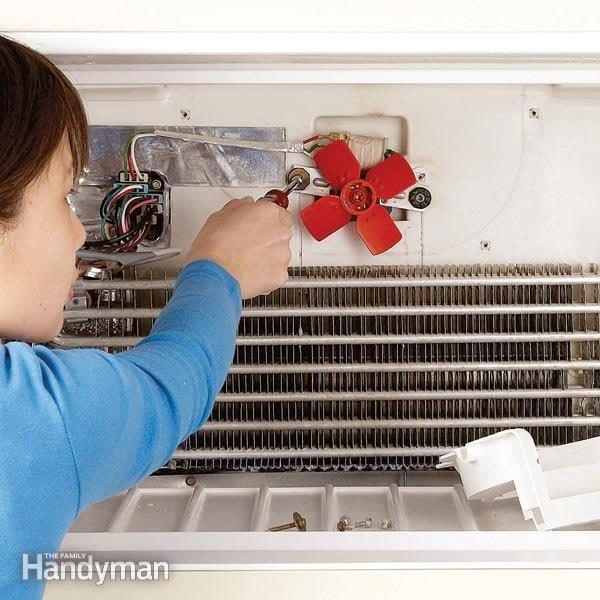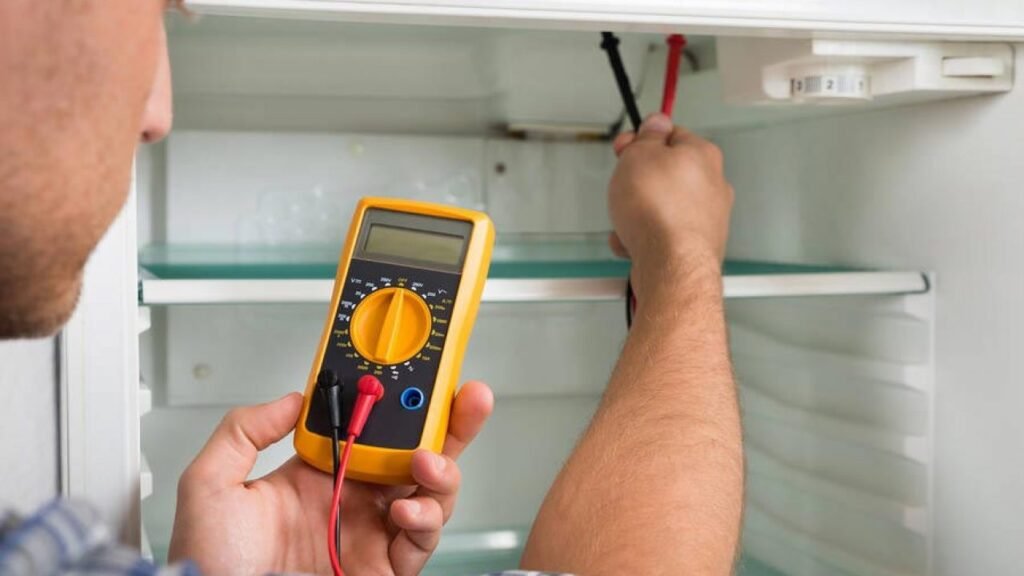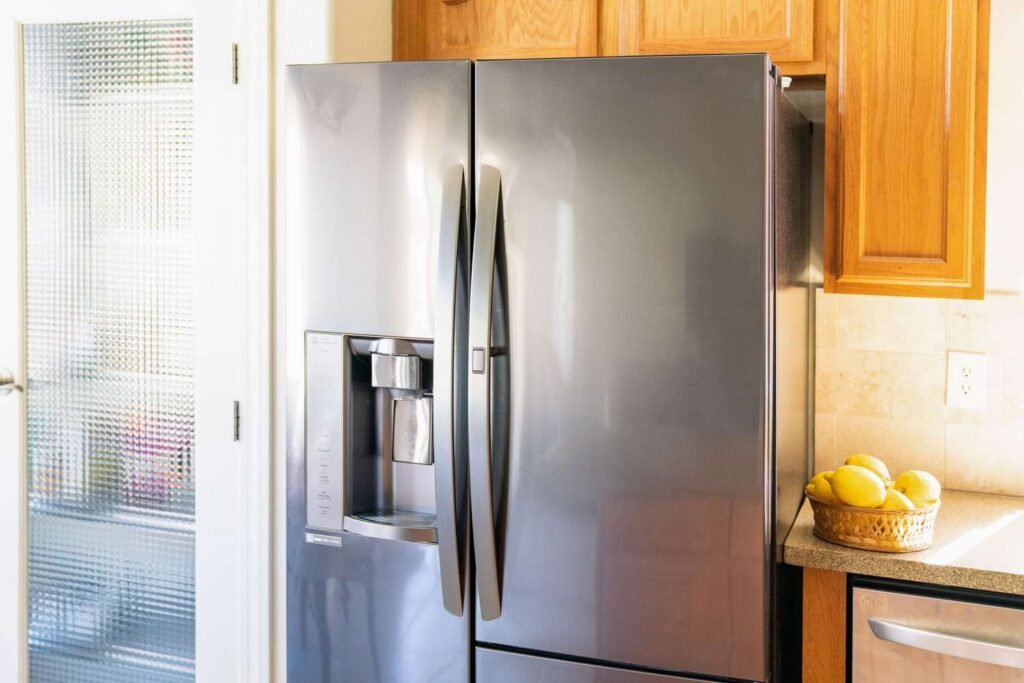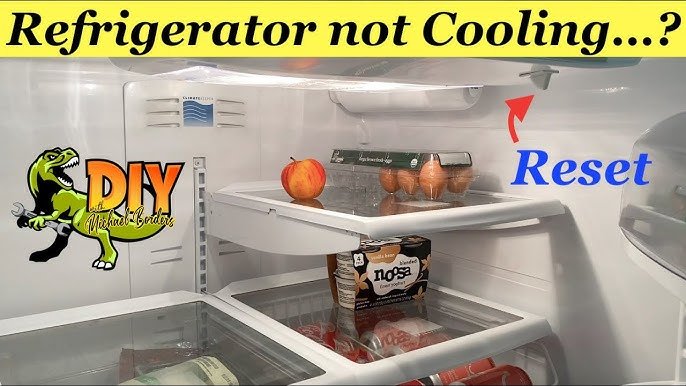
Imagine opening up your refrigerator to grab a cold drink on a scorching summer day, only to realize that it’s not as cool as you expected. Frustrating, right? In this article, we’ll explore some of the most common causes of a refrigerator not cooling properly and provide you with troubleshooting tips to help you get it back to its chilly best. No need to panic – we’ve got you covered!

This image is property of www.familyhandyman.com.
Dirty Condenser Coils
Dust and debris buildup
One common cause of a refrigerator not cooling properly is dirty condenser coils. Over time, dust, dirt, and other debris can accumulate on the coils located at the back or bottom of the refrigerator. This buildup creates a barrier that prevents proper heat transfer and can cause the refrigerator to struggle to maintain cool temperatures.
To troubleshoot this issue, start by turning off the refrigerator and unplugging it from the power source. Locate the condenser coils and visually inspect them for any visible dust or debris. If you notice a significant amount of buildup, it’s time to give the coils a good cleaning.
Using a vacuum cleaner with a brush attachment or a soft bristle brush, gently remove the dust and debris from the coils. Be careful not to apply too much pressure or damage the coils. Additionally, you can use a coil cleaning brush specifically designed for this purpose.
Regularly cleaning the condenser coils every six months or so is recommended to avoid this issue. By keeping the coils clean, the refrigerator will have better heat exchange efficiency, making it easier for it to maintain the desired temperature and prevent any cooling problems.
Lack of regular cleaning
In addition to dust and debris buildup on the condenser coils, another factor that can contribute to a refrigerator not cooling properly is a lack of regular cleaning. Over time, grime and dirt can accumulate on various components of the refrigerator, including the evaporator coils, fan motors, and vents. When these components become dirty, they can impede the proper functioning of the refrigerator’s cooling system.
To troubleshoot this issue, start by examining the various components of the refrigerator for any signs of dirt or grime. Check the evaporator coils, which are typically located behind a panel in the freezer compartment. If they appear dirty, you can use a soft brush to carefully remove any debris.
Next, inspect the fan motors for any visible dust or dirt. If the fan blades are dirty, use a damp cloth to gently clean them. Be sure to unplug the refrigerator before attempting any cleaning to ensure your safety.
Finally, check the air vents for any blockages. Food items, containers, or other objects can sometimes obstruct the vents and prevent proper airflow, which can lead to cooling problems. Remove any obstructions and rearrange items inside the refrigerator to ensure proper ventilation.
Regularly cleaning your refrigerator not only helps prevent cooling issues but also improves its overall efficiency and extends its lifespan. Set a schedule to clean and maintain your refrigerator, and you’ll be rewarded with a well-functioning appliance that keeps your food fresh and cool.
Faulty Thermostat
Inaccurate temperature reading
If your refrigerator is not cooling properly, a faulty thermostat could be to blame. The thermostat is responsible for regulating the temperature inside the refrigerator and ensuring that it stays within the desired range. If the thermostat is not working correctly, it may display an inaccurate temperature reading or fail to maintain a consistent temperature.
To troubleshoot this issue, start by checking the temperature settings on the thermostat. Ensure that the temperature is set to the recommended level for the refrigerator. If the temperature setting seems correct but the actual temperature inside the refrigerator does not match, you may need to recalibrate or replace the thermostat.
To recalibrate the thermostat, consult your refrigerator’s user manual for specific instructions. In some cases, you may need to contact a professional technician to assist with recalibration or thermostat replacement.
Thermostat not cycling properly
In addition to inaccurate temperature readings, a faulty thermostat may also fail to cycle properly. The cycling process involves the thermostat turning the cooling system on and off as needed to maintain a constant temperature. If the thermostat does not cycle properly, the refrigerator may run constantly, causing it to become too cold or unable to cool adequately.
If you suspect that the cycling of your thermostat is the issue, you can try manually forcing the cooling system off by adjusting the temperature control to the highest setting or turning off the thermostat altogether. Wait for a few minutes, and then turn the thermostat back on or adjust it to the desired temperature. If the refrigerator starts cooling correctly after this reset, it’s possible that the thermostat needs to be replaced.
Replacing a faulty thermostat should be done by a qualified technician, as it involves working with electrical components and ensuring proper calibration for optimal cooling performance. Contact a professional if you believe your thermostat is the cause of your refrigerator’s cooling problems.
Defective Evaporator Fan Motor
Fan motor not spinning
Another common cause of a refrigerator not cooling properly is a defective evaporator fan motor. This motor is responsible for circulating air over the evaporator coils to remove heat and maintain cool temperatures inside the refrigerator. If the fan motor is not spinning or fails to operate at the appropriate speed, it can result in poor airflow and insufficient cooling.
To troubleshoot this issue, start by listening for any unusual noises coming from the refrigerator. A distinct lack of noise or the absence of the usual sound of the fan motor may indicate a problem. You can also try opening the freezer compartment and checking for cold air blowing from the vents at the back. If there is no airflow, it is likely that the fan motor is not functioning correctly.
If the fan motor is not spinning, visually inspect it for any visible signs of damage or blockage. Sometimes, debris or ice can obstruct the fan blades and prevent them from spinning freely. If this is the case, carefully remove any obstructions and test the fan motor again. If the fan motor still fails to spin, it may need to be replaced.
Faulty motor control board
In some cases, a defective motor control board can contribute to the improper functioning of the evaporator fan motor. The motor control board is responsible for regulating the operation and speed of the fan motor. If the control board is faulty, it may not provide the necessary power or signals to the fan motor, resulting in cooling problems.
If you suspect that the motor control board is the issue, it’s best to seek professional assistance. A qualified technician will be able to diagnose the problem accurately and replace any faulty components if necessary. Trying to repair or replace the control board yourself without proper knowledge and experience with refrigerator repairs can lead to further damage or safety hazards.
Addressing any issues with the evaporator fan motor and motor control board is crucial for restoring proper cooling to your refrigerator. Consult a professional technician if you believe that these components are causing your cooling problems, as they can provide the expertise needed to diagnose and fix the issue effectively.
Malfunctioning Condenser Fan Motor
Fan motor not running
Similar to the evaporator fan motor, the condenser fan motor plays a vital role in maintaining proper cooling in a refrigerator. The condenser fan motor is responsible for removing heat from the refrigerant and expelling it from the refrigerator. If the fan motor is not running, the heat removal process is compromised, and the refrigerator may not cool adequately.
To troubleshoot this issue, start by listening for any unusual noises or lack of noise coming from the refrigerator. If you don’t hear the familiar sound of the condenser fan motor running, it indicates a problem. Next, visually inspect the fan motor for any visible signs of damage or obstruction. Make sure to unplug the refrigerator before attempting any inspection or repairs.
A common cause of a non-running condenser fan motor is a defective motor capacitor. The motor capacitor provides the initial boost of electrical energy to start the fan motor. If the capacitor is faulty, the fan motor may fail to start or run at the proper speed. Replacing the motor capacitor is relatively straightforward for those with some technical knowledge and experience with electrical components.
However, if the fan motor does not start even after replacing the motor capacitor, it’s best to consult a professional technician. They can diagnose the issue accurately, determine if the fan motor itself is defective, and handle any necessary repairs or replacements.
Addressing a malfunctioning condenser fan motor promptly is crucial for proper cooling and the overall performance of your refrigerator. Seek professional help if you are unsure about performing any repairs yourself to prevent any potential damage or risks.

This image is property of itisfixed.com.
Clogged or Frozen Evaporator Coils
Blockage due to dirt or debris
Clogged or frozen evaporator coils can significantly impact the cooling efficiency of a refrigerator. The evaporator coils are responsible for absorbing heat from the air inside the refrigerator, allowing it to cool down. Over time, dust, dirt, and debris can accumulate on the coils, restricting airflow and reducing their ability to remove heat effectively.
To troubleshoot this issue, start by inspecting the evaporator coils for any visible signs of contamination or ice buildup. If you notice a significant amount of dust or debris, use a soft brush or a vacuum cleaner with a brush attachment to gently remove it. Be cautious not to damage the delicate fins of the coils.
If the evaporator coils are frozen, indicating a problem with the defrost system, it’s best to defrost the refrigerator completely. Turn off the refrigerator, remove all perishable items, and allow the ice to melt naturally. Speeding up the process by using heat sources or sharp objects can damage the coils and other components.
To prevent future issues with clogged evaporator coils, it’s essential to keep the refrigerator clean and free from excessive moisture. Regularly check and clean the coils, ensure proper ventilation around the appliance, and promptly address any leaks or spills to minimize the chances of clogs or freeze-ups.
Faulty defrost system
In addition to dirt and debris, a malfunctioning defrost system can also contribute to evaporator coil clogs or freeze-ups. The defrost system is responsible for preventing the buildup of ice on the evaporator coils by periodically melting any accumulated ice. If the defrost system fails to function correctly, ice can accumulate and block proper airflow, leading to cooling problems.
If you suspect that a faulty defrost system is the underlying cause of your cooling issues, it’s best to consult a professional technician. They can perform a thorough inspection, diagnose the specific problem with the defrost system, and carry out any necessary repairs or component replacements.
Regular maintenance and cleaning of the evaporator coils, as well as addressing any issues with the defrost system promptly, are crucial for preventing clogs, ice buildup, and cooling problems in your refrigerator. A well-maintained and properly functioning defrost system will ensure efficient cooling and prolong the lifespan of your appliance.
Lack of Refrigerant
Leak in the refrigerant lines
Refrigerant is a crucial component in the cooling process of a refrigerator. It absorbs heat from the air inside the refrigerator and carries it to the condenser coils, where the heat is released. If there is a leak in the refrigerant lines, the refrigerator may experience a lack of refrigerant, resulting in inadequate cooling.
To troubleshoot this issue, you can start by listening for any hissing sounds coming from the refrigerator. A hissing sound could indicate a refrigerant leak. Next, visually inspect the refrigerant lines for any signs of oil stains, which are often an indication of a leak.
If you suspect a refrigerant leak, it’s important to contact a professional technician. Refrigerant is a hazardous substance that should only be handled by qualified individuals. A professional will be able to locate the leak, repair it, and recharge the refrigerant to restore proper cooling performance.
Insufficient refrigerant charge
In addition to a leak, insufficient refrigerant charge can also cause a refrigerator to not cool properly. If the initial refrigerant charge during the manufacturing process was incorrect or the refrigerant has been lost through normal wear and tear over time, the refrigerator may not have enough refrigerant to effectively remove heat and cool the interior.
Diagnosing and resolving issues related to the refrigerant charge should be left to professionals. They have the necessary tools and expertise to accurately measure the refrigerant level, determine if it is insufficient, and recharge the refrigerant as needed.
Attempting to address refrigerant issues without proper training and equipment can not only be dangerous but could also void any warranties on your refrigerator. It’s essential to contact a professional technician to handle any refrigerant-related problems to ensure safety, proper repair, and optimal cooling performance.

This image is property of www.thespruce.com.
Faulty Compressor
Compressor not running
The compressor is the heart of a refrigerator’s cooling system. It is responsible for pumping refrigerant through the system, which allows for the absorption and release of heat. If the compressor is not running, the refrigerator will struggle to cool properly, and the overall functioning of the appliance will be compromised.
To troubleshoot this issue, start by listening for any unusual noises coming from the refrigerator. Typically, you should be able to hear a consistent, low humming sound when the compressor is running correctly. If there is no sound or if you notice a clicking sound instead, it suggests a problem with the compressor.
Next, locate the compressor, which is usually located at the back of the refrigerator or at the bottom. Visually inspect the compressor for any visible signs of damage or overheating. If it appears damaged or exhibits signs of overheating, such as a burning smell or discoloration, it’s likely that the compressor needs to be replaced.
Addressing a faulty compressor is a complex task that should be left to professionals. Replacing a compressor involves working with refrigerant and electrical components, which require specialized knowledge and experience. Contact a qualified technician to diagnose the issue accurately and carry out any necessary repairs or replacements. Attempting to repair or replace the compressor yourself can lead to safety hazards and further damage to your refrigerator.
Inadequate compression of refrigerant
Another issue related to the compressor that can result in a refrigerator not cooling properly is inadequate compression of the refrigerant. If the compressor is running but fails to compress the refrigerant effectively, the cooling process will be compromised, leading to insufficient cooling.
Determining and addressing issues related to the compression of refrigerant requires professional expertise. A qualified technician will be able to diagnose the specific problem, whether it’s a faulty compressor valve or a malfunctioning pressure switch, and take appropriate measures to repair or replace the necessary components.
The compressor’s proper functioning is vital for the overall cooling performance of your refrigerator. Seeking professional help to address any compressor-related issues ensures that the repair is done correctly, minimizing potential risks and extending the lifespan of your appliance.
Damaged Door Gasket
Cracked or torn gasket
The door gasket, also known as the door seal, is a flexible rubber strip that lines the edges of the refrigerator door. It serves as a barrier to prevent warm air from entering the refrigerator and cool air from escaping. If the door gasket is damaged, with cracks, tears, or other defects, it can compromise the refrigerator’s ability to maintain cool temperatures.
To troubleshoot this issue, visually inspect the door gasket for any visible signs of damage. Pay close attention to areas where the gasket may be torn or no longer creating a proper seal with the refrigerator frame. Additionally, check for any accumulation of dirt or residue on the gasket, as this can also impact its effectiveness.
If you notice any damage or dirt on the door gasket, it’s essential to clean and repair or replace it. Cleaning the gasket is relatively straightforward – use a mild detergent or a mixture of water and vinegar to clean the rubber, and ensure it is completely dry before reattaching it to the door.
For minor cracks or tears, you can try using a silicone-based adhesive or sealant specifically designed for refrigerator door gaskets. Apply a small amount of adhesive to the damaged area, smooth it out, and let it dry according to the manufacturer’s instructions. Be cautious not to use excessive adhesive that may interfere with the gasket’s flexibility.
In cases where the door gasket is significantly damaged or cannot create an adequate seal, it’s best to replace it completely. Contact the refrigerator’s manufacturer or a professional technician to obtain the correct replacement gasket and ensure a proper installation.
Improper sealing of the refrigerator door
In addition to visible damage, an improper seal between the refrigerator door and the gasket can also cause cooling problems. If the door is not closing correctly or if there is any deformation in the refrigerator frame, it can prevent the door gasket from creating an airtight seal, allowing warm air to enter and cool air to escape.
To troubleshoot this issue, start by inspecting the alignment of the refrigerator door. Ensure that it is closing properly and making even contact with the gasket around the entire perimeter. If the door is misaligned or requires excessive force to close, it may need to be adjusted or repaired.
If you notice any deformations or gaps in the refrigerator frame, it’s best to contact a professional technician. They will have the necessary tools and expertise to correct any structural issues and ensure that the door closes properly to create a tight seal with the gasket.
Properly maintaining the door gasket and ensuring a tight seal with the refrigerator door is crucial for maintaining cool temperatures and preventing energy waste. Regularly clean the gasket, make any necessary repairs, and address any alignment or structural issues promptly to keep your refrigerator functioning optimally.

This image is property of empire-s3-production.bobvila.com.
Blocked Air Vents
Obstruction from food items
Blocked air vents can significantly impact the cooling efficiency of a refrigerator. Air vents are responsible for allowing cold air to circulate throughout the refrigerator, ensuring even cooling. When the vents become blocked, typically due to overcrowding or improper arrangement of food items, the airflow is restricted, leading to inadequate cooling in certain areas.
To troubleshoot this issue, start by inspecting the refrigerator’s interior and the placement of food items. Ensure that there is proper spacing between items and that nothing is directly blocking the air vents. Move any obstructing food items away from the vents to allow for better airflow.
Pay attention to shelving arrangements and ensure that taller items, such as milk cartons or beverages, are placed away from the vents. This will prevent them from blocking the flow of cold air and promote better circulation throughout the refrigerator.
Regularly organizing and decluttering the refrigerator not only helps prevent blocked air vents but also makes it easier to find and access your food items. Consider using storage containers or bins to keep similar items together and maximize space efficiency.
Improper arrangement of items
In addition to direct blockage of air vents, the improper arrangement of food items inside the refrigerator can also contribute to cooling problems. Poor organization can result in overcrowding, preventing proper airflow and causing certain areas of the refrigerator to become warmer than others.
To optimize the cooling efficiency of your refrigerator, consider the following tips when arranging food items:
- Group similar items together: Keeping similar items together allows for easier organization and retrieval, reducing the time spent with the refrigerator doors open.
- Leave space between items: Avoid overcrowding shelves and compartments, as it can restrict airflow. Leave enough space around items for cold air to circulate freely.
- Store temperature-sensitive items properly: Place perishable foods, such as raw meats and dairy products, in the coldest parts of the refrigerator, typically the lower shelves or compartments.
- Utilize crisper drawers effectively: Crisper drawers are designed to maintain higher humidity levels, making them ideal for storing fruits and vegetables. Keep these items separate from other foods to prevent premature spoilage.
- Be mindful of door storage: Door shelves are subject to temperature fluctuations, making them better suited for condiments, beverages, and other non-perishable items. Avoid storing highly perishable items, such as eggs or dairy, in these areas.
Regularly evaluating and adjusting the arrangement of food items in your refrigerator ensures optimal cooling and helps prevent temperature inconsistencies. By following these simple guidelines, you can maintain a well-organized refrigerator that cools effectively and keeps your food fresh.
Power Supply Issues
Improper voltage supply
The proper functioning of a refrigerator relies on a consistent and appropriate voltage supply. Fluctuations in voltage or inadequate power supply can result in cooling problems and potentially damage the refrigerator’s components.
To troubleshoot this issue, start by verifying that the refrigerator is connected to a properly grounded electrical outlet. Ensure that the outlet provides the necessary voltage as specified by the manufacturer. If possible, use a voltage meter or a multimeter to measure the voltage at the outlet.
If you notice significant voltage fluctuations or inconsistencies, it’s best to contact an electrician. They can assess your electrical system, identify any issues, and take appropriate measures to stabilize the voltage supply to your refrigerator.
Faulty electrical connections
Another potential cause of power supply issues is faulty electrical connections. Over time, connections can become loose or corroded, resulting in poor electrical flow and potential cooling problems.
To troubleshoot this issue, start by unplugging the refrigerator from the power source. Inspect the power cord and plug for any visible signs of damage, such as frayed wires or bent pins. If you notice any defects, it’s important to replace the power cord or plug to ensure a safe and reliable connection.
Next, check the electrical outlet where the refrigerator is plugged in. Ensure that the outlet is in good condition and provides a secure connection. If you notice any loose or corroded connections, it’s best to contact an electrician to properly address the issue.
It’s essential to address any power supply issues promptly to prevent further damage to the refrigerator and ensure proper cooling performance. If you suspect a power supply problem but are unsure about performing any repairs or replacements yourself, it’s best to consult a professional technician or electrician who has the expertise to handle such issues safely and effectively.
In conclusion, troubleshooting a refrigerator that is not cooling properly requires a systematic approach to identify and address the underlying causes. Dirty condenser coils, a faulty thermostat, defective fan motors, clogged or frozen evaporator coils, inadequate refrigerant, a faulty compressor, a damaged door gasket, blocked air vents, and power supply issues are common factors that can impact the cooling performance of a refrigerator. By following the guidance provided for each issue, you can troubleshoot and possibly resolve the problem, ensuring that your refrigerator operates efficiently and effectively to keep your food cool and fresh. Remember, when in doubt or when dealing with complex repairs, it’s always best to consult a professional technician who can provide expert advice and assistance.

This image is property of i.ytimg.com.






